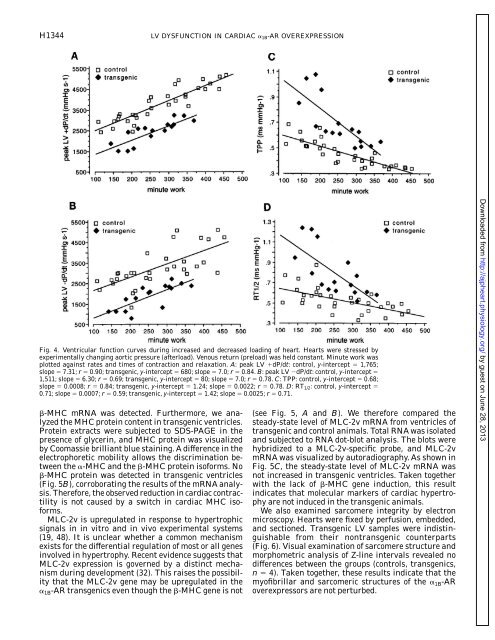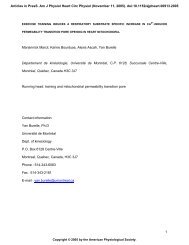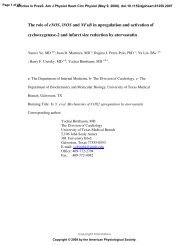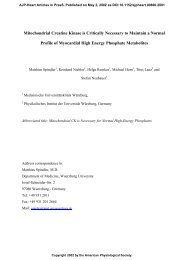Overexpression of 1B-adrenergic receptor induces left ventricular ...
Overexpression of 1B-adrenergic receptor induces left ventricular ...
Overexpression of 1B-adrenergic receptor induces left ventricular ...
You also want an ePaper? Increase the reach of your titles
YUMPU automatically turns print PDFs into web optimized ePapers that Google loves.
H1344 LV DYSFUNCTION IN CARDIAC <strong>1B</strong>-AR OVEREXPRESSION<br />
Fig. 4. Ventricular function curves during increased and decreased loading <strong>of</strong> heart. Hearts were stressed by<br />
experimentally changing aortic pressure (afterload). Venous return (preload) was held constant. Minute work was<br />
plotted against rates and times <strong>of</strong> contraction and relaxation. A: peak LV dP/dt: control, y-intercept 1,765;<br />
slope 7.31; r 0.90; transgenic, y-intercept 680; slope 7.0; r 0.84. B: peak LV dP/dt: control, y-intercept <br />
1,511; slope 6.30; r 0.69; transgenic, y-intercept 80; slope 7.0; r 0.78. C: TPP: control, y-intercept 0.68;<br />
slope 0.0008; r 0.84; transgenic, y-intercept 1.24; slope 0.0022; r 0.78. D: RT1/2: control, y-intercept <br />
0.71; slope 0.0007; r 0.59; transgenic, y-intercept 1.42; slope 0.0025; r 0.71.<br />
-MHC mRNA was detected. Furthermore, we analyzed<br />
the MHC protein content in transgenic ventricles.<br />
Protein extracts were subjected to SDS-PAGE in the<br />
presence <strong>of</strong> glycerin, and MHC protein was visualized<br />
by Coomassie brilliant blue staining. A difference in the<br />
electrophoretic mobility allows the discrimination between<br />
the -MHC and the -MHC protein is<strong>of</strong>orms. No<br />
-MHC protein was detected in transgenic ventricles<br />
(Fig. 5B), corroborating the results <strong>of</strong> the mRNA analysis.<br />
Therefore, the observed reduction in cardiac contractility<br />
is not caused by a switch in cardiac MHC is<strong>of</strong>orms.<br />
MLC-2v is upregulated in response to hypertrophic<br />
signals in in vitro and in vivo experimental systems<br />
(19, 48). It is unclear whether a common mechanism<br />
exists for the differential regulation <strong>of</strong> most or all genes<br />
involved in hypertrophy. Recent evidence suggests that<br />
MLC-2v expression is governed by a distinct mechanism<br />
during development (32). This raises the possibility<br />
that the MLC-2v gene may be upregulated in the<br />
<strong>1B</strong>-AR transgenics even though the -MHC gene is not<br />
(see Fig. 5, A and B). We therefore compared the<br />
steady-state level <strong>of</strong> MLC-2v mRNA from ventricles <strong>of</strong><br />
transgenic and control animals. Total RNA was isolated<br />
and subjected to RNA dot-blot analysis. The blots were<br />
hybridized to a MLC-2v-specific probe, and MLC-2v<br />
mRNA was visualized by autoradiography. As shown in<br />
Fig. 5C, the steady-state level <strong>of</strong> MLC-2v mRNA was<br />
not increased in transgenic ventricles. Taken together<br />
with the lack <strong>of</strong> -MHC gene induction, this result<br />
indicates that molecular markers <strong>of</strong> cardiac hypertrophy<br />
are not induced in the transgenic animals.<br />
We also examined sarcomere integrity by electron<br />
microscopy. Hearts were fixed by perfusion, embedded,<br />
and sectioned. Transgenic LV samples were indistinguishable<br />
from their nontransgenic counterparts<br />
(Fig. 6). Visual examination <strong>of</strong> sarcomere structure and<br />
morphometric analysis <strong>of</strong> Z-line intervals revealed no<br />
differences between the groups (controls, transgenics,<br />
n 4). Taken together, these results indicate that the<br />
my<strong>of</strong>ibrillar and sarcomeric structures <strong>of</strong> the <strong>1B</strong>-AR<br />
overexpressors are not perturbed.<br />
Downloaded from<br />
http://ajpheart.physiology.org/<br />
by guest on June 28, 2013






